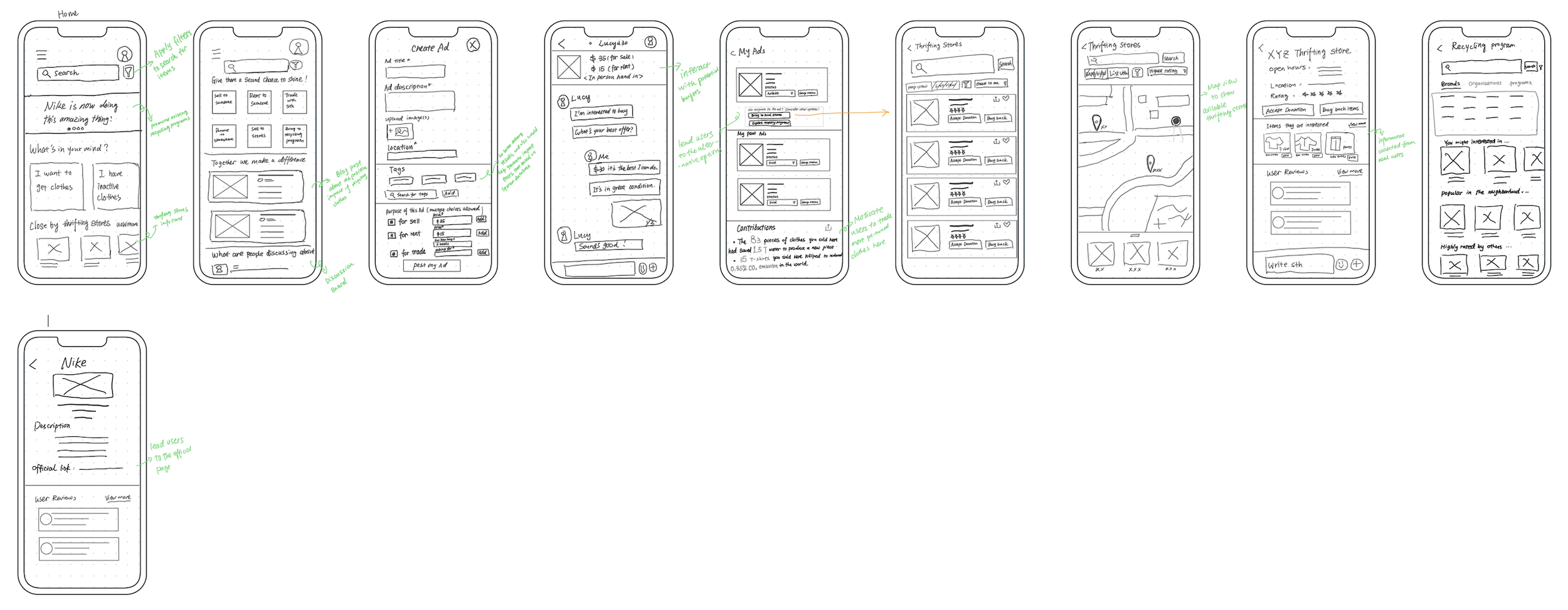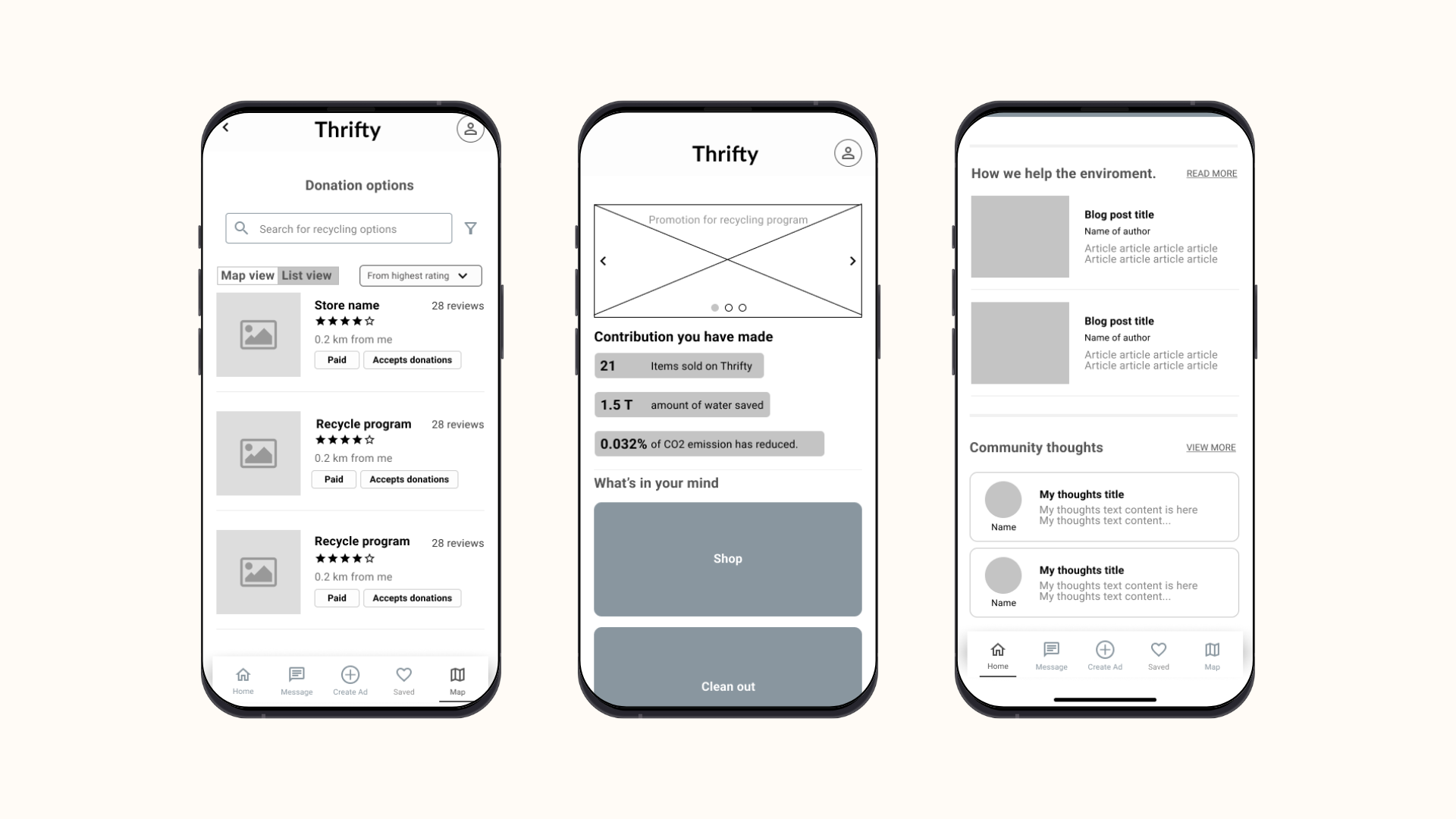
Thrifty
As the capstone project for my Master's degree in mid-summer 2022, I collaborated with three team members to develop a practical, effective, and highly motivating application. This app is designed to encourage consumers to focus on reusing and recycling clothing.
Role & Team
Teamed up with 3 team members, We worked together from business problem analysis to UX research and design/
Duration
2 Weeks (May 2022)
Overview
"Thrifty" is our school capstone project—a collaborative effort by my team of three members. We set out to tackle current sustainability challenges by creating a practical, user-focused app that benefits both businesses and consumers.
Tool
Figma & Miro
Scope
UI/UX, Data and business analysis, Wireframing, Competitive Analysis, Rapid Prototyping, User Flow, Persona

The Urgency of Climate Action
The rise in CO₂ levels in the atmosphere is accelerating global warming and climate change, leading to widespread environmental consequences.
🌍 The Impact on Our Planet:
Increased frequency and intensity of extreme weather events (hurricanes, wildfires, floods).
Rising sea levels, threatening coastal communities.
Disruptions to global food and water supplies, exacerbating scarcity and hunger.
Escalating climate migration, as populations are forced to relocate due to uninhabitable conditions.
While energy and transportation are often seen as the biggest contributors, nearly every industry has a carbon footprint. Addressing this challenge requires systemic changes across multiple sectors, including fashion and retail.
Existing Solutions & Strategies
To mitigate climate change, businesses and governments are exploring several key strategies:
1️⃣ Carbon Offsets
A carbon offset is a reduction in CO₂ emissions that compensates for emissions produced elsewhere. This includes:
✅ Reforestation projects – Planting trees to absorb CO₂.
✅ Investment in renewable energy – Supporting wind, solar, and hydropower.
✅ Carbon credit programs – Allowing companies to "neutralize" emissions by funding sustainability efforts.
2️⃣ Carbon Capture & Utilization (CCU)
Instead of just reducing emissions, capturing and transforming CO₂ offers a proactive approach:
🔹 Direct Air Capture (DAC): Extracting CO₂ from the atmosphere and storing it underground.
🔹 CO₂ to Products: Converting captured CO₂ into fuels, building materials, and even clothing fibers.
3️⃣ Reducing Greenhouse Gas Emissions at the Source
Industries are working on reducing emissions directly through:
🚗 Electrification of transport (EVs, public transit innovations).
🏭 Sustainable manufacturing (energy-efficient processes, lower-waste production).
👕 Circular economy in fashion (recycling textiles, reducing fast fashion waste).
The Key Problem Statement
How might businesses partner with their customers to reach their carbon offset goals and drive brand loyalty?
Problem Defination
-
Location
North America
-
Industry
Clothing / Fashion
-
Format
Mobile app platform
Background Research
1. The Climate Crisis & Fashion Industry’s Role
The rise in CO₂ levels is accelerating global warming and climate change, leading to widespread environmental and societal challenges:
🌍 Environmental Consequences:
More frequent and severe extreme weather events (wildfires, hurricanes, floods).
Rising sea levels, threatening coastal communities.
Disruptions to global food and water supplies, increasing resource scarcity.
Escalating climate migration, forcing populations to relocate due to unlivable conditions.
While industries such as energy and transportation are often blamed for emissions, fashion is a significant but overlooked contributor:
👕 The Fashion Industry’s Carbon Footprint
The fashion industry is responsible for 10% of global carbon emissions—more than aviation and shipping combined.
Over 92 million tons of textile waste are generated annually.
Fast fashion encourages disposable clothing habits, exacerbating the waste problem.
2. The Business Challenge: Balancing Sustainability & Profitability
Businesses today face a complex challenge:
✅ Meeting carbon reduction targets while maintaining profitability.
✅ Enhancing brand loyalty through sustainability-driven initiatives.
✅ Encouraging consumer participation in carbon reduction without imposing additional costs.
However, the current sustainability landscape is full of challenges:
🚨 Carbon offset costs – Many businesses shift the costs of sustainability efforts onto consumers.
🚨 Rising production expenses – Supply chain disruptions increase material costs.
🚨 Low consumer engagement – Many customers support sustainability in theory but lack motivation to take action.
Market & Competitive Landscape
To assess existing solutions and market gaps, we conducted a competitive analysis of platforms promoting circular fashion and sustainability-driven consumer engagement:
Envision
Sketches


Personas

Low-fi Prototype
Home - Main Page
Key Elements & Functionality:
Navigation Bar (Bottom Menu): Provides access to Home, Messages, Create Ad, Saved Items, and Account for seamless interaction.
Search & Filter Bar (Top): Allows users to find clothing items or thrift stores, with a filter option for refined searches.
Promotional Carousel: Highlights recycling programs, promotions, or sustainability initiatives, with swipe functionality for multiple banners.
User Action Section ("What's in your mind")
"I want to get clothes" – Leads to browsing thrift store listings or second-hand clothing options.
"I have inactive clothes" – Guides users to donation, recycling, or resale options.
Thrift Store Discovery Section: Displays nearby thrift stores with distance indicators, ratings, and basic store details. A "VIEW MORE" option allows users to explore additional stores.
Create & Edit Ads
This screen enables users to create an ad for selling, renting, or trading clothing items. It uses a clean layout and progressive disclosure to guide the user through the process without overwhelming them.
Clarity & Simplicity: Clear form sections help users understand required inputs without confusion.
User Empowerment: Multiple options (sell, rent, trade) support diverse user needs and encourage sustainable behavior.
Tagging System: Adding tags improves item discoverability and supports personalization later in the user journey.
This screen allows users to update an existing listing, preserving their input while offering flexibility to adjust item details, price, or availability.
Continuity & Context: Displays the existing ad preview at the top to maintain context and reduce cognitive load.
Efficiency: Reuses the same form layout as "Create My Ad" for a consistent user experience.
Control: Lets users update specific fields like price, tags, or rental duration without needing to start from scratch.
Usability Test
Moderated Testing
Objectives
Validate clarity and intuitiveness of key flows (e.g., creating/editing an ad, recycling flow).
Identify any friction points or confusion in navigation.
Test whether the app’s sustainability incentives are clear and motivating.
-
Task 1: Create a New Ad
Scenario: "You want to sell a jacket you no longer wear. Show me how you'd post it."
What to Observe: Can they complete the flow without asking questions? Do they hesitate when choosing tags or categories? -
Task 2: Edit an Existing Ad
Scenario: "You want to lower the price on your listing. Try to update it."
What to Observe: Do they understand where to find and edit their post? Is the preview helpful or distracting? -
Task 3: Explore Recycling Options
Scenario: "You want to donate clothes instead of selling them. Where would you go?"
What to Observe: Can they find the relevant flow? Is the language clear (e.g., 'inactive clothes')? -
Task 4: Understand Rewards
Scenario: "How would you earn points? What can you do with them?"
What to Observe: Do users understand the value proposition? Are rewards motivating?
Testing Results
What People Are Saying
Users confuse "inactive clothes" with deleted items
Reword to "clothes you no longer wear" or "ready to part with"
Users forget to preview their ad before posting
Add a gentle nudge or optional preview pop-up
Tagging step slows users down
Provide tag suggestions or pre-defined tags
Reward system unclear
Add a visual explainer (e.g., progress bar or tooltip on how points are earned)
Design Changes
Messaging Experience: From Bidding to Direct Contact
Before: Users were offered options to bid, rent, or trade—leading to potential decision fatigue and emotional discomfort.
After: Replaced bidding with a simple message interface and auto-generated templates to reduce friction and encourage dialogue between users.
Design Rationale: Removed emotionally charged bidding to improve user comfort and streamline negotiation.
Homepage Improvements: Motivation & Simplification
Before: Featured a search bar, neutral action buttons, and limited user feedback.
After:
Removed the search bar to declutter the UI.
Reworded CTA buttons to “Shop” and “Clean out” for clarity.
Added personalized impact metrics (e.g., items sold, water saved) to motivate sustainable action.
Moved the account icon to the top right and added consistent headers.
Design Rationale: Improved hierarchy and personalization to boost user engagement and focus user intent.
Donation Flow: Reducing Cognitive Load
Before: Six similar options made the donation decision overwhelming.
After: Condensed the options into two clear CTAs—“I want to donate my clothes” and “I want to sell my clothes.”
Design Rationale: Streamlined user flow to reduce decision fatigue and support faster, more confident action.

Hi-fi Prototype
Onboarding Flow
Map & List View for Donation Options
This screen offers users two ways to explore nearby thrifting and recycling locations—list view and map view. The filter menu allows users to customize the view based on type (e.g., paid, thrift, or recycling only).
Design Focus:
Empowers users with flexible discovery methods.
Enhances transparency with location, ratings, and donation acceptance tags.
Promotes ease of access and choice for sustainability-driven actions.
Updated Homepage with Personalized Impact
This updated homepage introduces personal and collective environmental impact metrics and restructured CTAs like “Shop” and “Clean Out.”
Design Focus:
Motivates users with visible contributions (e.g., items sold, CO₂ saved).
Simplifies navigation and enhances clarity through redesigned CTA buttons.
Reinforces purpose-driven engagement while keeping the interface clean.
Action-Oriented Sustainability Hub
This screen encourages users to take action—donate, recycle, or sell clothing—and provides curated access to both recycling programs and thrifting stores.
Design Focus:
Simplifies decision-making through clear, action-oriented buttons.
Organizes resources visually, making it easy to browse and act.
Creates a centralized space for all reuse-related activities, boosting usability and follow-through.













